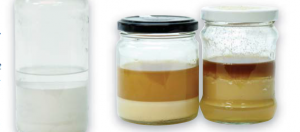We may receive a commission when you use our affiliate links. However, this does not impact our recommendations.

The three types of green solvents that Bob Flexner discusses in his article – paint thinner, lacquer thinner and denatured alcohol.
After a 20-minute drive through Boston-area traffic and a 20-minute walk around the periphery of the home center in search of someone who could direct me to the finishing supplies aisle, I recently found myself staring at a surprisingly limited selection. I had walked right past it a couple times in my little hike. There were maybe six rows of shelves, mostly devoted to stains that I didn’t need.
But there were two options for paint thinner (mineral spirits), which is one more than I expected to find. In addition to the brightly painted metal canister that you see everywhere, there was a white and green plastic bottle with a round sticker that said “non-flammable.” There was also a statement on the label claiming that the product was safer for your lungs and easier on the environment. I was skeptical, but the price was right and I decided to give it a shot.
The “green” mineral spirits have been working really well for me, especially in an apartment living/working space where ventilation and fire safety are of highest importance. When I took the plunge, I had not yet read Bob Flexner’s article on these products. Bob seems to agree that some of the green solvents are very comparable to their other-than-green counterparts.
What follows are the key facts from Bob’s 2012 article on this topic. If you need some of the best advice on finishing, don’t delay in buying a copy of “Flexner on Finishing” from our store during the big Fall Sale. This book is my current pick for your collection!
–Dan Farnbach
Excerpt from “Green” Solvents
by Bob Flexner

On the left, green mineral spirits poured from the bottle and allowed to settle. On the right, two mixtures of oil-varnish finishes that include settled green mineral spirits.
1. Paint thinner (mineral spirits). The green paint thinners are the most unique of the green solvents category. They are emulsions, which means that the oily petroleum distillate is combined with water so that only 30 to 40 percent of the product is actually petroleum distillate. And it is even “greener” than regular paint thinner because some of the bad stuff, such as sulfur and aromatic hydrocarbons, has been removed.
As with all emulsions, green paint thinners are white in liquid form, but the whiteness disappears from the thinner as it dries. Unlike many other emulsions, however, green paint thinners separate if left standing, so you have to shake or stir them before each use.
Another difference to be aware of is the water content. It will cause the first coat of any product you thin with green spirits to raise the grain of the wood. You have to sand off the raised grain, and this risks sanding through to the wood and maybe removing some color if it’s been stained.
On the positive side, cleaning brushes is actually easier with the green paint thinners because of the emulsion.
2. Green lacquer thinners. These lacquer thinners contain mostly acetone and a little very slow-evaporating solvent to allow the lacquer to level and resist dry spray and blushing.
It may take a few trials to get used to the evaporation rate of a green lacquer thinner so you avoid orange peel, but this isn’t different than just switching brands, because all brands of lacquer thinner evaporate a little differently.
3. Green denatured alcohol. To make a denatured alcohol that is free of hazardous air pollutants (HAPs), manufacturers use only ethanol (the alcohol in beer and wine) with a little of something else to make the product poisonous so it isn’t taxed like liquor. Therefore, green denatured alcohols vary little from regular denatured alcohols. They may take a little longer to dissolve shellac flakes, but they are no different for thinning already dissolved shellac.
Here are some supplies and tools we find essential in our everyday work around the shop. We may receive a commission from sales referred by our links; however, we have carefully selected these products for their usefulness and quality.









My shop is in my basement, which is un-insulated and un-heated, and houses my furnace and gas water heater. Needless to say, I don’t use any flammable liquids down there, which means I do my finishing work outside. Since winter is coming, I’m wondering which finishing products I can use indoors without worrying about causing a fire or releasing toxic fumes. It would be great to have a handy list of finishing products that fit the kitchen table test. What can I use at my kitchen table without fear of burning the house down or poisoning the air? If I use shellac, what can I use to dissolve it? What about oils (such as walnut oil)? Water-based lacquers and polyurethanes? I’ve been reading about PolyWhey, a whey-based polyurethane from Vermont Natural Coatings, but haven’t seen any substantial articles or reviews in the woodworking magazines (aside from a small one in Fine Woodworking in 2008). I’m not looking for anything technical or comprehensive, just specific information and products I can use.
In hopes of finding denatured alcohol comprising 90+ percent ethanol (and as small a percentage of truly noxious solvents as possible), I recently spent quite a bit of time reviewing the MSDS (Material Safety Data Sheet) on the each of the denatured alcohols commonly available. One of the products pictured in your article, Crown Denatured Alcohol NEXT, came out on top, containing 90-100% ethanol and 0-5% isopropanol (rubbing alcohol). The rest of the products I studied contained high percentages of such toxic substances as methanol and methyl isobutyl ketone.
As you might expect, I was troubled to learn last week from Packaging Service Company, the outfit that manufactures Crown-brand solvents, that Crown Denatured Alcohol NEXT has been discontinued. The inside salesperson with whom I spoke could offer no explanation as to why.
With safety at the forefront of many woodworking discussions, I think we should all pay close attention to the solvents we use and take proper precautions. At least as far as denatured alcohol is concerned, manufacturers appear to have their heads in the sand.
While political correctness is a significant problem, I do believe that if we use our technology to concentrate or modify certain chemicals, then we should use, store and render them safe to those who follow.
Can the emulsified mineral spirits be mixed with linseed oil and used to build a finish. What do the emulsifiers and the water do to subsequent coats? Would sanding be required on a second coat?
NoelNNY is only partly correct – there is an old “law” of physics that says matter can neither be created nor destroyed, but humans have created a vast number of ways of altering the forms of matter, in some cases to substances that are more damaging to life than their precursors – these are indeed NEW products. Another change is to extract and concentrate one ingredient of a mixture such as petroleum, and when using one of those isolates, the individual is exposed to much more than if it had remained in the larger mixture, and the surrounding atmosphere becomes more polluted with whatever evaporates, is spilled or washed away, etc. While we have no control over those pollutants released by “natural” processes such as volcanoes or decaying life forms, that is not an excuse for isolating or modifying, and releasing, pollutants from other sources if alternatives are found and made available.
I tend to agree with George Carlin – man does not pollute the world or it’s environment – think about it – nothing – literally NOTHING which “mankind” supposedly invented, developed or manufactures already existed – we have not created anything new – just variations and mixtures of existing materials. How much “green” pollutants filter through the atmosphere every time a volcano erupts? Toxic gases continually flow up through the “black smokers” at the bottom of the ocean – algae blooms existed long before the industrial age and have killed countless billions of aquatic life….all at Mother Natures hands
Styrofoam and plastics are from petroleum, as are many of these solvents – nothing new in them – just mixed with other natural preexisting elements…so solvents are technically green – whether they have high VOC’s or little or none.
Man has not created anything new – it’s not in our talents – but we do manufacture a gazillion things from materials and chemicals and gases already in existence.
So why should we be shelling out our hard earned “green” only to buy over priced “green” stuff??
I can remember when Green was just a color, and not the best color. Green stuff on bread was and is not good, green wood is only good for use in rustic or Windsor chairs. Solvents are not “Green” they are solvents. Please spare us the political correctness as relates to cutting down trees and turning them into beautiful and practical objects that can last hundreds of years.